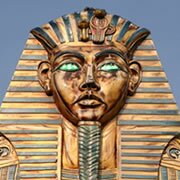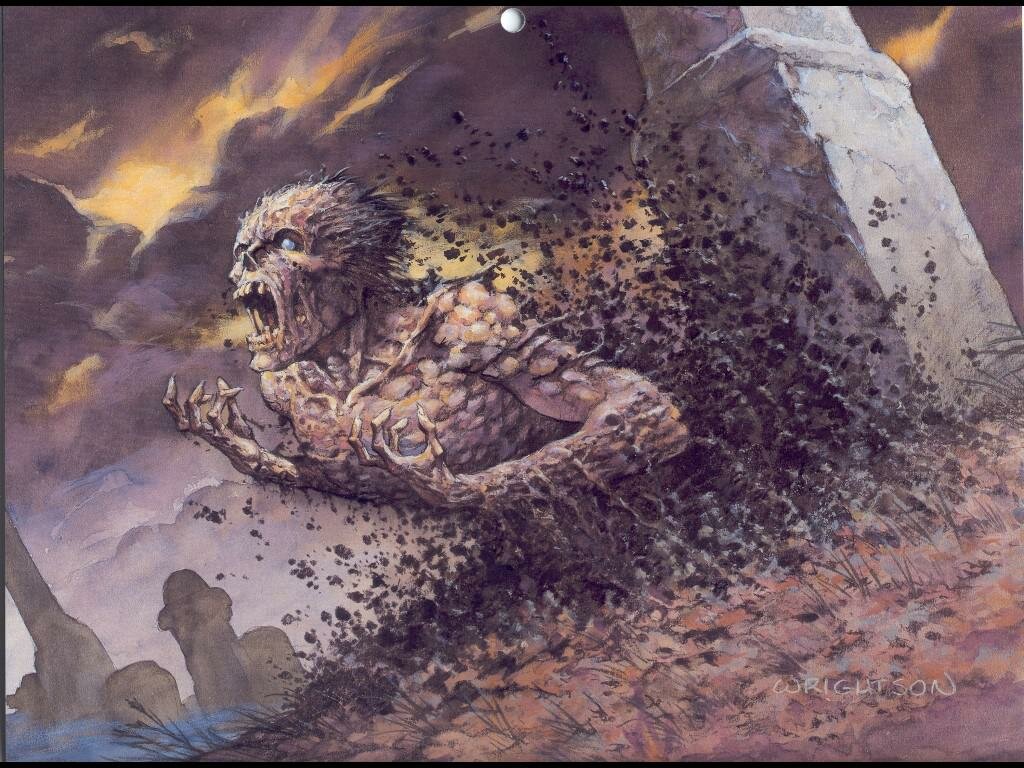Top 10 Cursed Relics throughout History
Suggested by SMSWhen most people associate the word “Cursed” with ancient relics, objects, places, and artifacts, they think of bestselling fiction novels, block buster movies, popular videogames, and of course, “Indiana Jones.” With that said what if there were actual reported cases of unexplainable mishaps related to a painting, necklace, or antique. This is a list of alleged cursed relics that have been connected with misfortune, illness, and even death.
10. The Curse of the Crying Boy Portrait

In 1985, in a small mining town in Rotherham, England, the Hall family became victims of an uncontrollable house fire that left their home in ashes. The ground floor of the home was reduced to rubble, yet on item remained unscathed by the devastation of the house fire. There hanging unaffected by the blazing fire was a framed reprint of the crying boy portrait.
There have been several stories and alleged cases related to “The Crying Boy Portrait” suggesting that this was not the first time a home or building was ablaze, and the only object remaining was an untouched portrait of the crying child.
The bizarre story caught the attention of “The Sun” a newspaper in the United Kingdom, the front page cover story read: “Blazing Curse of the Crying Boy”. And so the curse of The Crying Boy Portrait began, gaining attention throughout the United Kingdom as hundreds of the Giovanni Bragolin mass produced portrait were assembled and set on fire to authenticate the curse of the Crying Boy Portrait. It has been whispered the only way to lift the curse is to reunite the Crying Boy and Crying Girl Portrait.
9. The Curse of The Koh-i-Noor Diamond

This fabulous 186-carat diamond has been surrounded by mystery and misfortune for hundreds of years, and according to legend, the “Mountain of Light” was stolen from the God Krishna. The first recorded history of the Koh-I Noor Diamond appears in Mogul records as part of spoils of war in 1304. Regrettably, when Delhi was overrun by the Persian Army, the Mogul emperor hid the magnificent diamond in his turban. The Persian Nadir Shah seized the turban and gave the diamond its name. It was acquired by the British East India Company after being in Persian possession for nearly 110 years. The curse has been associated with royal men, because misfortune and death seems to follow any royal male that has been in possession of the Koh-I Noor diamond. Thankfully for the Queen of England, bad luck has not followed her, since the Koh-I Noor diamond has been in the coronation crown since 1911.
8. The Curse of The Croesus Treasure known as the “Lydian Hoard

The Lydian Hoard is a remarkable collection of artifacts, ancient jewelry, and relics from the time of King Croesus, ruler of the Lydian Kingdom between 560 and 547 B.C.
The alleged curse of the Croesus treasure began in 1965, when it was unearthed in the small village of Güre in the western province of Uşak. The treasure was discovered when five villagers found a tomb of an unknown princess who lived in the Lydian era. The villager’s ransacked the tomb, removing valuable jewels, and anything of value that had been buried with the Lydian princess. The looters continued to visit the area and in 1966, 150 relics were removed from the location; gold jewelry, silver, and even the wall paintings of the tombs were pilferage with hopes of the villagers obtaining vast wealth from selling the Croesus treasure, but instead of unimaginable wealth the villagers and their families have been scorned with misfortune, death, and so the legend of the Croesus Curse began.
7. The Curse of The Maori Warrior Masks

The Maori are a group of Polynesian people that are indigenous to New Zealand. They traveled to the land between 800 and 1350 AD in groups of 100, aboard 8 canoes that measured at 100 feet long. It’s said that the expedition was headed by a Polynesian chief who was aware of the amount of jade in New Zealand. The people settled in Te-Ika-a Maui, creating their own community. The name of the group, Maori, is simply translated to “human”.
The Maori tribe was one of warriors. Prior to going to battle, fighters would carve masks and statues. The spirit of any Maori man who lost his life in battle would overtake the specially carved pieces. However, the masks are believed to bring harm to women who are pregnant or menstruating. Although no one can really say for sure if the curse is real or not, a New Zealand museum that was featuring an exhibition of Maori artifacts felt it necessary to warn the public. The museum posted a warning add, suggesting that any women that was pregnant or menstruating should enter at her own risk, better to be safe than sorry, no doubt.
6. The Curse of The Uluru Rock

This rock formation, located in central Australia is also known as Ayers Rock. It is one of two major features in the Uluru-Kata Tjuta National Park. Sacred to a group of people known as the Anangu, Uluru Rock is also listed as a World Heritage site.
Anything sacred is not to be disturbed. This is also the case with removing rocks from Uluru. It is believed that those who do take rocks from Uluru will be cursed to suffer from illness and bad luck. Many have come to feel as though there is some merit to the ancient belief since there have been record of people who have taken rocks from the sacred location, have been reported to be o mailing the stolen rocks back to various agencies in an effort to remove the curse.
5. The Curse of the Terracotta Army

Wang Puzhi, was one of a seven workers that, while digging a well on their farm in Yang village in 1974, stumbled across one of the most exciting archaeological discoveries of the twentieth century; the 2,200-year-old Terracotta Army. The famous Terracotta Army brought wealth to many people throughout China, but unfortunately, the seven villagers that unearthed the magnificent Terracotta Army received nothing from the Chinese government for the historical find. The farmers have since been forced to relocate and have felt the impact, devastation, and misfortune of the glorious find. The farmland was claimed by the Chinese government, the homes of the families that lived in the 2,000 year old village destroyed and demolished; the village is no longer there, just a memory to the villagers of what was once their home and livelihood. Three of the farmers, who uncovered the Army died. Wang Puzhi, died by his own hand and several others died having nothing to pass on to family members. Today, there are four of the seven original members that accidently came upon the Terracotta Army in 1974, they work at the gift shop selling souvenirs to tourists, earning £2 a day.
4. The Curse of the Argonaut Treasure

Andrei Chamkin, An archaeologist searches for the Argonaut treasure for 15 years, with hopes of recognition and unfathomable wealth. Once Chamkin finally discovered the stunning treasure estimated to be worth $50,000.00 each piece. It was considered an amazing find, full of gold and silver, many people associated with the black market for antiquities purchased items from the Argonaut treasure for undisclosed amounts. Though the treasure is now in a museum, the archaeologist’s family that found the hidden treasure have felt the misfortune of the Argonaut curse, 15 members of the family have mysteriously died.
3. The Curse of The Little Bastard

The Little Bastard was the name that James Dean gave his Porsche Spyder in 1955. It was one of only 90 that were manufactured. His friends tried to warn him when he purchased it. They felt like the car was bad news. Unfortunately, they were right. James Dean died in The Little Bastard on September 30th 1955.
Master customizer, George Barris, purchased the wrecked vehicle for less than $3,000. When the car arrived at his shop, it fell on top of one of the mechanics as it was being unloaded. The mechanic suffered two broken legs. Barris realized at that moment that the car was trouble.
In the fall of 1956, Barris’ feelings were confirmed. During a race, two cars that had parts from The Little Bastard crashed. The driver of the car that was running on the Porsche’s engine, died. The other driver survived but reported that the locked on him when he was entering the curve.
Afterwards, a young man trying to steal the Porsche suffered an arm wound when the steering wheel slipped. Another man almost died when two of his tires blew out at the same time; the tires were taken off of The Little Bastard. There were mishaps with the car until 1960. The car disappeared while it was being transported as part of an exhibit. No one has ever located it.
2. The Curse of The Hope Diamond

Le bleu de France, as the Hope Diamond is also called is kept in the Smithsonian Museum. The 45.52 carat diamond is blue to the eye because of boron that is contained in its structure. It was formed in the Earth over 1 billion years ago. The diamond has been in many lands and many hands, including a few Kings. Unfortunately, wherever it went, its notorious curse followed.
The diamond is said to bring bad luck and tragedy to any person who wears or owns it. Most people simply assumed that the myth was created to increase the diamond’s value and reputation. Yet, oddly enough there have been news stories that aided in adding more mystery to the big, blue gem. Sadly, none of them were pleasant.
One news account told of Jacques Colet purchasing the diamond from another man; he later committed suicide. The man, who purchased it from Colet, was killed by Russian revolutionists. The woman, who borrowed it from that man, was killed by her lover. There were at least 10 more accounts given in this same article that was published in the New York Times in 1911. There was never any true confirmation of any of these things happening.
Some people believe that the Pierre Cartier made all of the stories up to entice a buyer. No one needs to worry anymore. It’s very unlikely that the museum will be loaning it out or selling it to anyone.
1. The Curse of the Pharaoh:
This ancient curse is based on the belief that if a person disturbs the mummy of any ancient Egyptian, especially that of a pharaoh will be cursed. This curse doesn’t discriminate and it doesn’t matter if the culprit is a thief or an archeologist; bad luck, illness or death is the cost of disturbing the peace of a resting pharaoh. There has been debate over whether not the curse is real.
One of the reasons many doubt the authenticity of the curse is that there can be scientific basis for illness and death. Bacteria that have grown in the underground tombs of the sleeping kings can cause irreparable damage to the human respiratory system. This can be the underlying cause of any death or sickness.
There have been many reported versions, related to the opening of King Tutankhamun Tomb, once such version is that Howard Carter found and unusual clay tablet in the Antechamber of the lost king’s tomb. A few days after cataloguing it, the story suggests that, Alan Gardiner deciphered the hieroglyphics. The tablet read: Death will slay with his wings whoever disturbs the peace of the pharaoh.
Both Carter and Gardiner viewed the curse as a warning to tomb robbers, but the tablet is alleged to spook away the local workers, all accounts of the mysterious tablet were removed from the documented records. The tablet itself disappeared, of course, never having been photographed or sketched. So, there is no solid evidence that the tablet even existed, only speculation.
The second version of the curse proclaims that on entering the second golden shrine, above the door read: They who enter this sacred tomb shall swift be visited by wings of death.
- Of the 26 people present at the opening of the tomb, 6 had died.
- Of the 22 people present at the opening of the sarcophagus, 2 had died.
- Carter died in 1939 at age 64, Harry Burton died in 1940 at age 60, and Sir Alan Gardiner died in 1963 at age 84.
The tomb was first opened in November of 1922. No one knows for sure if the curse is the real but many people remain skeptical.
While superstition and legend may be associated with the relics in this list, there are some people that may suggest that the Curse to any given relic is real and the documented consequences are the living proof that some relics might be better off left hidden and unearthed. Though numerous relics in this list have been considered great archeological finds, the misfortune, illness, and death that has been linked to several of these relics could be considered coincidental, or are the mishaps and ill-fated fortunes a reflection of the curse that is associated with each relic. No one may ever the truth, but many people throughout the world have felt the impact of these curses first hand.











I don’t know if these things are true but I won’t bother finding out.what a great research.thanks people
[...] Via Akhorra. [...]
[…] Cursed relics. […]